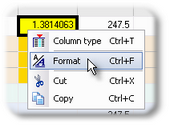Like most spreadsheets, FormCalc SST gives you options for formatting calculated results (for writing back to QuickBooks), and also for formatting data cells—cells which don't contain formulas but to which your formulas may refer.
Why Format Cells?
Formula Cells
The results calculated by formulas get written to your QuickBooks form. So, formatting formula cells not only makes calculated results more readable in FormCalc SST but also determines how those results will appear in QuickBooks.
Data cells
Data cells are those which don't contain formulas but to which formulas may refer. For instance, if a formula on the Formulas row refers to a cell in the Header section for a number it uses, you may consider that Header cell a data cell. The formula might also refer to some other cell on the Formulas row, or to a cell on its anchors row. Both could be considered data cells.
Formatting data cells is always optional. The main reason to do so is to make the sample data they contain (if any) more readable.
For example, spreadsheet cells represent date and time data internally as a decimal number such as 41596.775—something most of us would not recognize easily as a date or time. But a Date or Time format can be applied to 41596.775 so that it is displayed as 18 November 2013 or as 6:35pm. (The date and time are both encoded in the number 41596.775.)
You use the Format data or results dialog (described next) to format both data cells and formula cells.
Formatting a Cell
To format a cell, use the Format data or results dialog:
1.Click on the cell you want to format.
| FormCalc SST's main focus is on formatting formula cells. So if you click on an anchor row or other nearby cell, the formula cell may be the one which actually gets formatted. |
2.Either click on the Format button in the editing toolbar, or right-click the cell and select Format from the pop-up menu, as shown below.

| The Format data or results dialog will open (shown farther below) |
3.Select the formatting options you want.
4.Click OK to close the dialog.
The Format data or results Dialog

| The column type of the current Snapshot column determines which formats are available. If a format isn't available in this dialog and you think it should be, check to see it the correct column type has been assigned. |
Spreadsheet format
This section in the left pane of the dialog, is where you choose a format type and a format to apply to the cell you are formatting.
QuickBooks output
This section in the right pane of the dialog, gives you additional control over how the cell's calculated results will be sent to QuickBooks.
Numbers
The spreadsheet formatting options available for numbers (in the left pane) are a bit limited. Many of them support no more than two decimal places, while some QuickBooks fields allow up to five decimal places (Quantity and Rate columns) or more. The Numbers section lets you override a spreadsheet cell's format when sending its calculated result to QuickBooks, giving you more control over decimal places and whether commas are used.
Though omitted from the screenshot above, newer editions of FormCalc SST support yet another kind of override: sending results to QuickBooks as mixed fractions. For instance, if a result is calculated in FormCalc SST as 1.75, selecting this override sends the result to QuickBooks as 1-3/4. Negative numbers are sent surrounded by parentheses: -2.5 would be displayed as (2-1/2).
Description column output
This section only appears when you are formatting the Description column.
As you probably know, when you select an Item on a QuickBooks form the Description column is automatically filled with the Item's description. You may or may not want to overwrite the Item description with results sent from FormCalc SST. This section gives you options for whether or not to overwrite the description, whether results appear on a separate line from it, and how many spaces to indent the results.
"Help bubbles"
Help bubbles provide detailed information about the various formatting options.. Hovering the mouse cursor over a help bubble displays a pop-up window with information about the adjacent option.